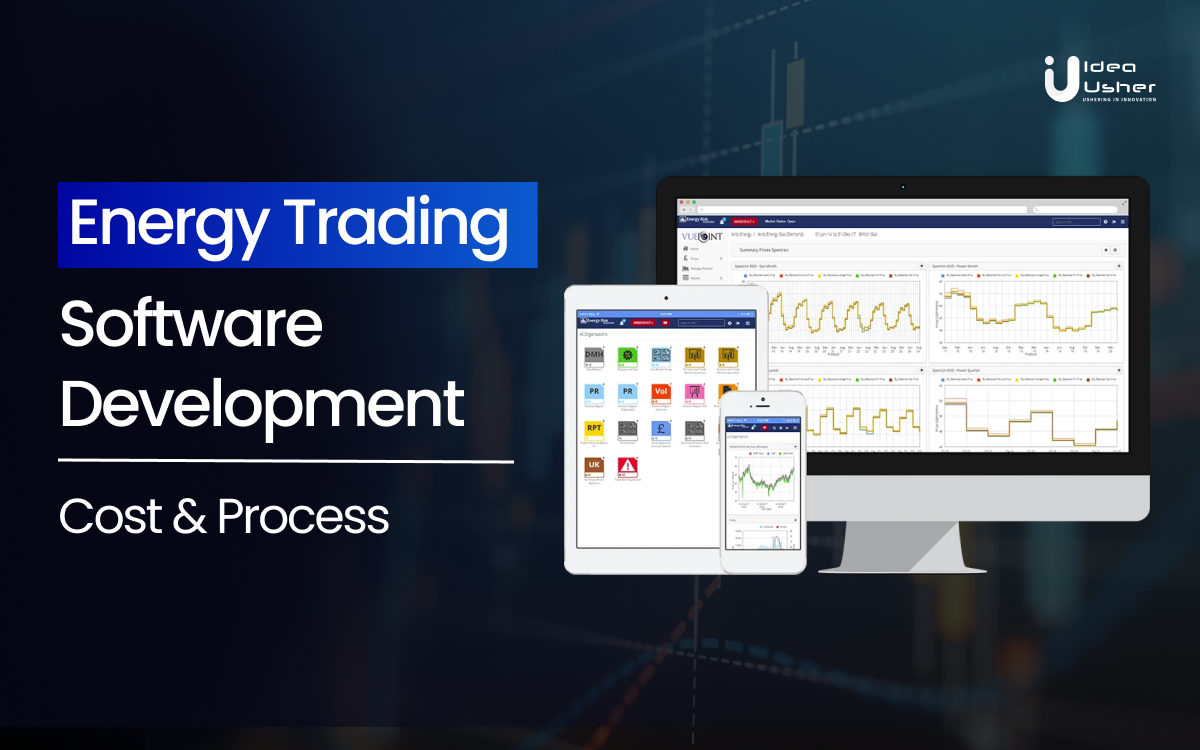In the field of energy, there is a growing need for more and more solutions that can address the key pain points, like manual processes, lack of real-time data, complex regulations, and risk management challenges. A perfect tool can help in managing those issues and the complexities of trading energy commodities such as crude oil, natural gas, electricity, and renewable energy sources. Energy trading software, also known as energy trading and risk management systems, is a tool for participants that facilitates the buying, selling, and trading of energy commodities and derivatives. These platforms incorporate technologies that meet the demands of traders, brokers, and energy-producing entities.
In this blog, we will explore the development of energy trading software, its key features, and the technology stack behind it. We will help you understand everything that it takes to create an effective ETRM system and the revenue potential it holds.
Energy Trading Software: Overview
Energy trading software is designed to manage the buying and selling of energy commodities like electricity, natural gas, crude oil, and renewables. These platforms provide essential tools for capturing trades, analyzing risks, processing settlements, and meeting regulatory requirements.
ETS automates many tasks, reducing errors and allowing for quick trade execution. It includes advanced tools to help traders manage risks related to price changes, credit issues, and regulatory compliance. This software is also scalable, which makes it suitable for handling increasing trade volumes and the growing complexity of the energy markets. It brings together market data from various sources and helps traders make informed decisions. This comprehensive approach ensures that traders can operate efficiently, manage risks effectively, and stay compliant with regulations in a constantly changing energy market.
Key Features Of Energy Trading Software
Energy trading software addresses the complex needs of modern energy markets. Here are some features that set a high-quality Energy Trading and Risk Management or ETRM system apart:
- Comprehensive Trade Management: Manages all trade activities, from capturing deal details to overseeing contracts and settlements, ensuring seamless operations throughout the process.
- Advanced Risk Management: Offers tools to identify, evaluate, and mitigate financial and operational risks, protecting against market volatility and unexpected disruptions.
- Real-Time Market Analysis: Provides live data analytics, enabling traders to respond swiftly to market changes and optimize strategies based on up-to-the-minute information.
- Automated Trading Systems: Incorporates algorithms that execute trades automatically, optimizing timing and pricing without requiring manual intervention.
- Portfolio Optimization: Facilitates the dynamic management of diverse energy portfolios, including generation assets, contracts, and positions, maximizing returns while minimizing exposure.
- Regulatory Compliance Management: Ensures that all trading activities align with industry regulations and environmental standards, reducing the risk of legal complications.
- Predictive Analytics and Forecasting: Uses historical and current data to forecast market trends, aiding in strategic planning and informed decision-making.
- Automated Settlement Processes: Streamlines settlement and invoicing, enhancing accuracy and speeding up the financial closure of trades.
- Integrated Reporting and Audit Functions: Delivers customizable reporting and strong auditing capabilities, enabling detailed analysis and compliance tracking.
- Market Data Integration: Connects with multiple data sources, providing traders with accurate, up-to-date market information for well-informed decisions.
How Does Energy Trading Software Work?
Energy Trading and Risk Management systems simplify the complexities of trading energy commodities. These systems integrate key functions into a single platform and make sure that a simplified trading process is delivered. Here is how it works:
1. Capturing Trade Details
Every trade, including contract specifics and transaction records, is precisely documented. This ensures transparency and accuracy and provides a reliable record of all trading activities.
2. Managing Financial Risks
Markets can be volatile, which makes risk management highly important. ETRM systems assess and monitor financial risks, which help traders eliminate potential losses and maintain balanced strategies.
3. Integrating Real-Time Market Data
Access to real-time data on prices, supply, and demand is also important. ETRM systems continuously gather this information and allow traders to make informed decisions and stay ahead of market trends.
4. Automating Trade Execution
Automated trading tools within ETRM systems optimize trade execution. These tools analyze market conditions and execute trades at optimal times, which reduces manual intervention and enhances efficiency.
5. Managing Portfolios
ETRM systems provide tools to optimize and balance energy portfolios. This includes adjusting trading positions and managing assets to align with market conditions and ensure maximum returns.
6. Ensuring Regulatory Compliance
Compliance with industry standards and environmental regulations is also equally important as the other things in this context. ETRM systems make sure that all trading activities meet these requirements, with detailed reporting and auditing features for easy monitoring.
7. Simplifying Settlement And Invoicing
Automated settlement and invoicing processes reduce errors and speed up financial transactions. This ensures accuracy and efficiency in billing and cultivates trust between trading partners.
Key Market Takeaways For Energy Trading Software
In 2023, the global energy trading and risk management market was valued at $1.47 billion. This market is expected to grow at a compound annual growth rate (CAGR) of 4.4% from 2024 to 2033, reflecting the increasing demand for efficient energy trading solutions.
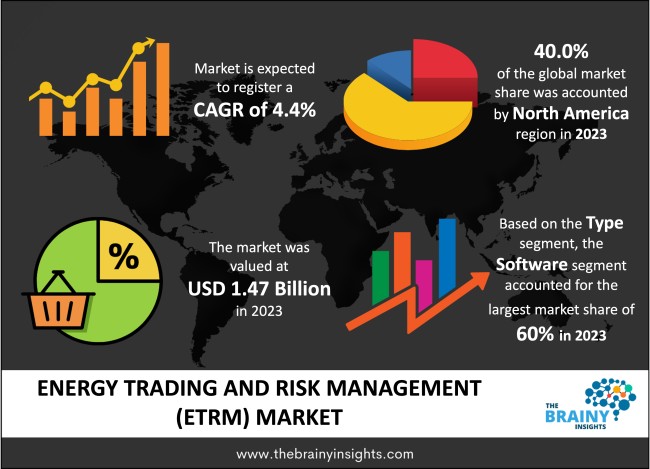
Similarly, another report highlighted that the Energy Trading and Risk Management market, valued at $24.1 billion in 2023, is projected to reach $31.2 billion by 2031. This growth, with a CAGR of 3.24% from 2024 to 2031, underscores the market’s expansion driven by the complexity of energy trading and the need for robust risk management tools.
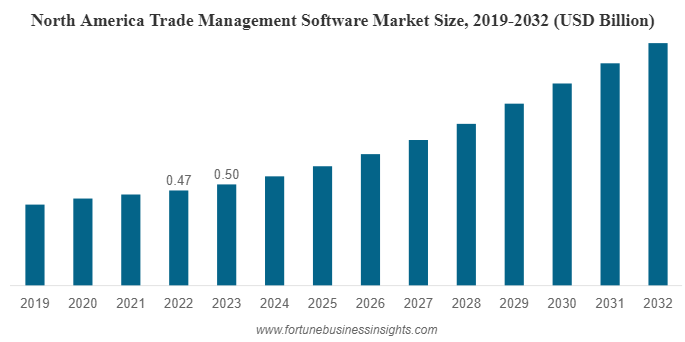
Alongside the ETRM market, the global trade management software market was valued at $1.29 billion in 2023 and is forecasted to grow from $1.41 billion in 2024 to $3.16 billion by 2032, exhibiting a significant CAGR of 10.7%. This growth is largely fueled by the rise in international trade due to globalization, coupled with the increasing demand for automation in trade management operations, creating substantial opportunities for market expansion.
Why Are Energy Trading Software In Demand?
The need for energy trading software has increased due to several key factors unfolding in the energy market:
1. Handling Renewable Energy
As more solar and wind power is added to the energy mix, managing these variable sources becomes challenging. Energy trading software helps track and adjust to the ups and downs of renewable energy. It helps in keeping trading operations stable despite fluctuating supply.
2. Support For Decarbonization
With a global push towards cleaner energy, there’s a growing market for carbon credits and low-carbon products. Energy trading software enables traders to navigate these new opportunities and facilitate the trading of sustainability-focused instruments.
3. Managing Geopolitical Risks
Geopolitical issues and trade disputes can cause disruptions in the energy market. Energy trading software provides tools to handle these risks and helps traders adjust their strategies in response to global events.
4. Embracing New Technologies
The energy sector is adopting new technologies like blockchain and the Internet of Things. Modern energy trading software incorporates these advancements, improves data analysis, automates processes, and secures transactions.
5. Adapting To Regulations
Energy trading rules are constantly changing with new innovations and upgrades. Their energy trading software helps traders stay compliant with new regulations and makes sure that they meet legal requirements and avoid penalties.
Types Of Energy Trading Software
Energy trading software is essential for managing the complexities of energy markets, with different types designed for specific needs. The two main categories are ETRM systems and CTRM systems:
1. ETRM: Energy Trading And Risk Management Systems
ETRM systems focus on the energy sector and manage the trading of electricity, natural gas, oil, and renewable energy. These platforms handle every aspect of energy trades, from the initial transaction to the final settlement. They offer tools that help traders assess and manage market risks, ensuring informed decisions in fluctuating markets. Additionally, ETRM systems support compliance with industry regulations, simplify the reporting process, and reduce the risk of legal issues.
2. CTRM: Commodity Trading And Risk Management Systems
CTRM systems have a broader scope, covering a wide range of commodities such as energy, metals, and agricultural products. These platforms share many features with ETRM systems, including risk management and compliance support, but are designed to handle the complexities of trading various types of commodities. CTRM systems allow traders to manage different commodity portfolios within a single platform and ensure a unified and efficient trading process across multiple markets.
| Feature/Aspect | ETRM | CTRM |
| Scope | Focuses specifically on energy commodities such as electricity, natural gas, oil, and renewable energy. | Covers a wide range of commodities including energy, agricultural products, metals, and more. |
| Users | Primarily used by energy trading companies, utilities, energy producers, and suppliers. | Firms, investment banks, financial institutions, and companies dealing with multiple commodities. |
| Regulatory Compliance | Energy-specific regulations | Regulations across various commodities |
| Risk Management | Specialized risk management for energy markets, including price volatility, supply and demand fluctuations, and environmental risks. | General risk management for diverse commodities, addressing market risks, credit risks, and operational risks. |
| Forecasting Models | Energy-specific forecasting | Broad forecasting models |
| Trade Capture | Energy trades only (physical and financial) | Trades for various commodities (physical and financial) |
| Logistics and Scheduling | Energy logistics and delivery | Logistics for multiple commodities |
| Settlement and Invoicing | Streamlines settlement and invoicing processes specific to energy trades. | Facilitates settlement and invoicing for diverse commodity trades. |
| Market Integration | Energy market integration | Integration with various commodity markets |
| Customization | Often includes energy-specific modules and features. | Offers modular solutions that can be customized for different commodities. |
Must-have Features For Energy Trading Software
Effective energy trading software needs to be reliable, efficient, and equipped with features that address the challenges of the energy market. Here are some essential features that any energy trading software should include:
1. Market Access And Workflow Automation
The ability to seamlessly integrate into day-ahead, real-time, and supporting markets is important. Automation of these workflows ensures quick participation, reduces manual errors, and keeps operations smooth.
2. Risk Management Tools
Identifying and managing financial risks is a top priority in energy trading. The software should offer real-time risk assessment tools to handle price changes and market fluctuations, which can help traders maintain stability and protect profits.
3. Advanced Analytics And Forecasting
Real-time access to market data and historical insights is always important. The software should provide strong analytics to predict energy demand, price trends, and supply conditions to help traders make informed decisions.
4. Efficient Trading And Settlements
Automating trading activities and streamlining settlements ensures accuracy and efficiency. This feature reduces errors in transactions, speeds up the settlement process, and keeps everything on track.
5. Regulatory Compliance Management
Keeping up with changing regulations is undoubtedly essential. Your software should include features that ensure compliance with market rules, environmental standards, and financial reporting to avoid any legal complications.
6. Automated Trading Algorithms
Automated algorithms are key to faster and more accurate trade execution. These algorithms optimize trading by analyzing data and executing trades based on preset strategies, which reduces the risk of human error.
7. Portfolio Management
Managing and adjusting energy assets and contracts in real-time is essential for staying aligned with market conditions. Your software should provide tools to keep portfolios balanced and focused on maximizing returns.
Development Steps For Energy Trading Software
Building a top-tier energy trading software involves a well-planned sequence of steps, such as:
1. System Architecture Design
Begin with designing a system architecture that accommodates real-time data integration, predictive analytics, and scalability. Determine the appropriate data sources, such as grid and weather data, and establish the necessary infrastructure for data integration. Plan for the integration of blockchain and AI for advanced offerings. Make sure that the architecture supports cloud-based deployment to ensure flexibility and cost-efficiency.
2. Data Integration And API Development
Develop APIs and integration modules to connect with external data sources. This includes integrating real-time grid data from sources like ISO New England or ERCOT and weather data from providers such as AccuWeather. Ensure that the system can handle large volumes of data and provide real-time updates. Establish data pipelines for seamless data flow and accuracy.
Work to integrate energy trading software with existing energy management systems. This can be the key to optimizing trading strategies. Include features that support participation in demand response programs, like load shedding and curtailment, and enable more dynamic trading. You can also integrate your software with energy storage systems that can further enhance the platform’s ability to manage price volatility and optimize trade execution.
3. Risk Management And Compliance Tools
Create tools for managing risk and ensuring regulatory compliance. Develop statistical models, like GARCH or ARIMA, for price volatility and implement risk management features to handle physical delivery and regulatory risks. Build functionalities to support compliance with emissions trading schemes and other market regulations. Testing these tools in various scenarios is important to ensure their effectiveness.
4. Predictive Analytics And AI Integration
Incorporating AI into energy trading software can significantly enhance predictive capabilities. Machine learning models, trained on historical market data, can forecast future price movements and identify emerging patterns, allowing traders to refine their strategies. Moreover, natural language processing can analyze news and social media to gauge market sentiment and help your user identify trends that may affect energy prices.
5. Blockchain Implementation
Implement blockchain solutions to ensure the traceability of renewable energy, verifying its authenticity, which is increasingly important for compliance and credibility in green markets. This step requires building and testing blockchain components to ensure they function correctly within the energy trading system. Plus, implement smart contracts, which can automate trade execution, settlement, and reconciliation processes, minimizing counterparty risks.
6. Cybersecurity Measures
Establish cybersecurity protocols to protect the system from threats. Conducting threat modeling can help you identify potential risks, and you can implement measures to eliminate them. Additionally, developing an incident response plan ensures that the platform can respond effectively to cybersecurity threats while maintaining the integrity and resilience of trading operations.
7. Cloud Deployment And Scalability
Deploy the software on a cloud-based infrastructure to handle increasing trading volumes and market complexity. Configure the cloud environment for scalability and ensure that resources can be adjusted based on demand. Optimize cloud usage for cost-efficiency and performance and ensure that the system can scale seamlessly as needed.
Tech Stack For Energy Trading Software Development
Here are the specific tech stack elements that are required for the energy trading software development:
| Feature/Aspect | Tech Stack for Energy Trading Software |
| Energy Market Integration | Eikon API (Thomson Reuters), ICE Data Services, Bloomberg Terminal API |
| Energy-Specific Analytics | Plexos, Aurora, MATLAB |
| Energy Trading Platforms | Allegro, OpenLink Endur, Trayport |
| Regulatory Compliance | EMIR Reporting, Dodd-Frank Compliance, REMIT Reporting |
| Energy-Specific Risk Management | Numerix, Kiodex |
| Energy Logistics and Scheduling | ABB Ability™ Energy Portfolio Management, OATI webTrader |
Cost Of Developing Energy Trading Software
The cost of developing energy trading software can vary widely based on the complexity, features, and the development team’s location. Here are the costs involved in different stages and features:
| Phase | Description | Minimum Cost | Maximum Cost |
| Planning and Analysis | Requirement Gathering | $500 | $5,000 |
| Design | UI/UX Design for energy trading | $1,500 | $8,000 |
| Development | Frontend Development | $1,000 | $11,000 |
| Backend Development | $1,500 | $12,000 | |
| Integration | Market Data Integration (Eikon API, ICE Data Services, Bloomberg Terminal) | $3,000 | $12,000 |
| Risk Management Tools (Numerix, Kiodex) | $800 | $20,000 | |
| Regulatory Compliance (EMIR, Dodd-Frank, REMIT) | $500 | $10,000 | |
| Testing | Functional, Performance, Securtiy Testing | $300 | $7,000 |
| Deployment | Cloud Services (AWS, Azure, GCP) | $400 | $5,000 |
| Maintenance and Support | Ongoing Support (updates, bug fixes, enhancements) | $500 | $10,000 |
| Total Cost Range | – | $10,000 | $100,000 |
Cost-Affecting Factors To Consider For Energy Trading Software Development
Here are the primary elements influencing the overall expense of energy trading projects:
1. Real-Time Data Integration
Paying for real-time data from sources like Bloomberg or Reuters can be costly. Ensuring this data is accurate involves additional checks, which increases the overall development cost.
2. Regulatory Compliance
Different regions have different rules, and keeping up with these can be expensive. Regular updates to comply with changing regulations, such as those for emissions, add to both initial and ongoing costs.
3. Risk Management Capabilities
Developing advanced tools to manage risks, such as credit and operational risks, requires specialized knowledge and resources. Creating models to analyze various risk scenarios adds to development costs.
4. Integration With Market Infrastructure
Connecting the software with market systems, like grid operators and trading platforms, involves technical challenges. This integration requires specific solutions and increases overall costs.
5. Cybersecurity And Data Privacy
Meeting cybersecurity and data privacy standards, like GDPR and CCPA, adds to development costs. Implementing strong security measures and keeping data safe requires extra planning and resources.
6. Scalability And Performance
The software must handle market changes and high trading volumes efficiently. Designing it to perform well during sudden price swings and increased trading activity requires significant investment.
7. Specialized Knowledge
Hiring experts in energy markets and technical fields raises costs. Expertise in areas like real-time data processing and risk modeling is necessary but can be expensive while ensuring the software meets industry standards.
Top Trending Revenue Generating Methods For Energy Trading Software
To increase revenue in energy trading, focus on these effective strategies:
1. Use Data Analytics To Increase Revenue
Real-time grid data helps you make better trading decisions and directly boost your profits. Weather forecasts improve predictions for energy supply and demand, especially for renewables, allowing you to take advantage of market shifts. Market intelligence reports offer insights into trends and regulations, enabling you to adopt more profitable trading strategies.
2. Cut Costs Through Compliance
Software that ensures compliance with emissions trading schemes helps avoid expensive fines, protecting your revenue. Tracking renewable energy purchases to meet Renewable Portfolio Standards (RPS) prevents penalties and can unlock government incentives. Adhering to grid codes avoids disruptions and legal issues, keeping your revenue secure.
3. Increase Earnings With Specialized Strategies
Using specialized strategies like power purchase agreements and renewable energy certificates opens up new revenue sources. Implementing demand response strategies lowers energy costs and boosts profitability by optimizing usage. Trading carbon credits not only meets regulatory requirements but also provides additional income from credit sales.
4. Protect Revenue With Risk Management
Tools for hedging against price volatility, such as futures and options, help stabilize your revenue. Effective credit risk management prevents financial losses from defaults, safeguarding your income. Addressing operational risks, like supply chain issues, ensures smooth trading and prevents revenue loss.
5. Expand Market Reach To Maximize Revenue
Integrating with grid operators provides real-time data and trading opportunities, enhancing your market access and increasing revenue potential. Connecting with various trading platforms broadens your trading opportunities, allowing you to tap into more markets. Linking with Energy Management Systems improves energy use and trading decisions and drives higher revenue.
6. Boost Profits With Effective Training
Training on energy markets, trading strategies, and risk management improves your trading skills and leads to higher profits. Customized training programs meet specific needs and enhance performance, which directly contributes to revenue growth. Investing in education helps make better decisions, resulting in increased financial returns.
Top 5 Energy Trading Software In 2024
Here are the top choices of energy trading software in 2024:
1. Comcore

Comcore is a powerful platform for managing both physical and paper trades. It centralizes trade components and offers advanced risk management tools, such as Mark-to-Market valuations and Value-at-Risk analysis. With features like automated invoicing, Profit & Loss reporting, and seamless integration with third-party systems, Comcore is designed to streamline trading operations and support business growth.
2. Lancelot
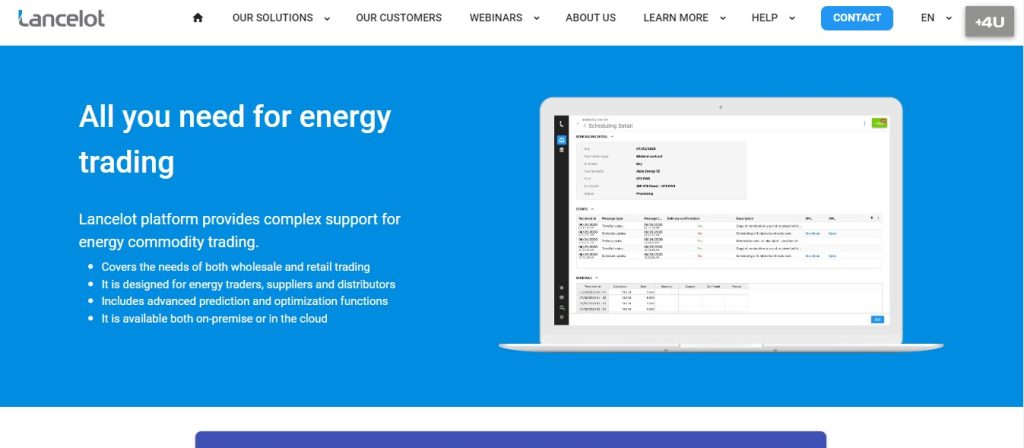
Lancelot is a comprehensive solution for trading across various energy markets. It uses AI, machine learning, and data science to help traders make smarter decisions and maximize profits. Lancelot’s Energy Trading and Risk Management (ETRM) system handles transactions, risk monitoring, and workflow automation. Additionally, Lancelot’s Forecasting and Management System (FMS) provides accurate predictions for energy prices and renewable production, giving traders a significant edge.
3. K3 by BroadPeak Partners

K3 is a smart data integration tool that simplifies how businesses handle data in energy trading. It allows users to unify and transmit data across different platforms, including both legacy systems and modern cloud applications. K3’s features include a user-friendly interface, a rules engine for data enrichment, and strong filtering capabilities to keep data clean and accurate, ensuring reliable decision-making.
4. Brady Technologies
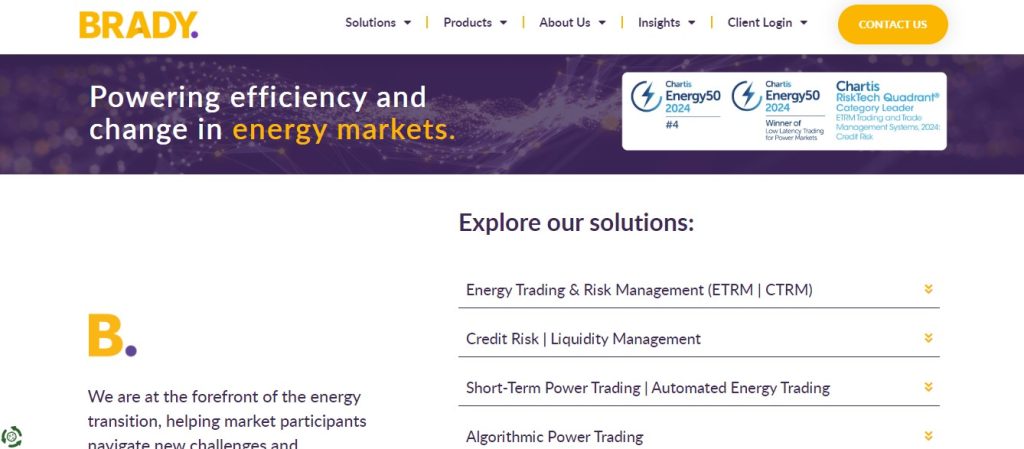
Brady Technologies offers advanced software solutions that help businesses navigate the complexities of the energy market. Their tools optimize trading operations, manage risks, and improve decision-making. Brady’s software supports increased automation and efficiency, making it easier to adapt to changes in market dynamics, including decentralization and new regulations.
5. Molecule

Molecule stands out as a modern alternative to traditional ETRM/CTRM systems. Built natively for the cloud, it delivers a user-friendly interface and near real-time reporting. With over 30 integrations, Molecule ensures a seamless and hassle-free implementation process. It offers advanced P&L, near real-time Value-at-Risk (VaR), and position reporting, making it an ideal solution for companies trading various commodities.
Conclusion
The energy market is becoming complex with the rise of renewables and new technologies. This is the reason for more effective trading software. These energy trading tools make it easier to manage trades, reduce risks, and comply with regulations. Investing in such systems can help you make smarter decisions and improve your profits. As the energy industry evolves, staying ahead with advanced software will be important for long-term success and growth. So, embracing these solutions will help you to navigate the changing market and achieve better results in your operations.
Looking To Develop Energy Trading Software?
Our team excels in developing customized solutions that meet the unique demands of the energy market. We focus on delivering efficient, reliable software that integrates smoothly with your existing systems and adapts to your business growth. From real-time data management to advanced risk assessment and compliance, we ensure every aspect of your software enhances performance and drives profitability. You can trust us to build a platform that supports your trading strategies and boosts your operational efficiency. So, contact us today to start developing a custom energy trading solution that aligns with your goals.
Work with Ex-MAANG developers to build next-gen apps schedule your consultation now
FAQ
What is energy trading software?
Energy trading software is a digital tool designed to facilitate the buying, selling, and management of energy commodities such as electricity, oil, and gas. It integrates various functions, including trade execution, risk assessment, and compliance management, to streamline operations and enhance decision-making within energy markets.
What is the technology for energy trading?
The technology behind energy trading includes advanced data analytics, real-time market data integration, and automation tools. It utilizes APIs for data sourcing, machine learning for predictive analysis, and blockchain for secure transactions. This technology supports efficient trading, risk management, and regulatory compliance in dynamic energy markets.
What is the business model of energy trading?
The business model of energy trading typically involves purchasing energy commodities at a lower price and selling them at a higher price to generate profit. It also includes managing risks through hedging strategies, trading derivatives, and optimizing portfolio performance. Revenue is earned through trading margins, fees, and commissions.
What is an energy trading and risk management system?
An Energy Trading and Risk Management system is a comprehensive platform that manages the trading of energy commodities and associated risks. It integrates functionalities for trade capture, risk analysis, compliance, and settlement, helping traders make informed decisions and efficiently handle market volatility and regulatory requirements.
